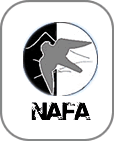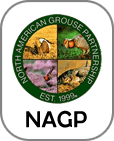Author: Bruce A. Haak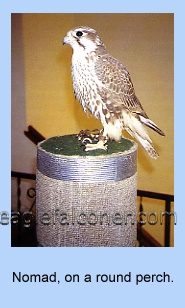 (Reprinted here with the permission of the Author)
(Reprinted here with the permission of the Author)
I called him "Nomad" because I didn't know where he had come from and I wasn't sure where he was going. Such is the nature of passage prairie falcons, winged hunters that might traverse half of the temperate latitudes of western North America during their lifetimes. The prairie falcon is North America's only indigenous falcon Prairie Falcon called Nomadspecies, and most of its habitat lies within the borders of the United States. The heart of its range and the largest concentration of eyries are in southwest Idaho, where I moved in 1984. At the Snake River Canyon, which is a short drive south of my home, huge basalt cliffs line the canyon walls. Some 15 thousand years ago, a breach in the dam of prehistoric Lake Bonneville created a canyon carved in chaos.
From Utah came a rolling wall of water, estimated to be 400 ft. high, careening down the river on its way to the Columbia River and, ultimately, to the Pacific Ocean. Over 80 miles of river canyon and half a million acres of public land have been set aside as the Snake River Birds of Prey National Conservation Area.
For thousands of years, windblown soil from the volcanically active Cascade Range to the west has been deposited on the north side of the river. A sandy loam of uniform texture some 4-6 ft. deep, the soil is the ideal environment for digging mammals. Here, the greatest concentration of badgers and of nesting raptors in North America share a dependence on an unusual prey species. Resembling small prairie dogs, Townsend ground squirrels spend most of their lives below ground, in the domain of the badger. They estivate most of the year, living on stored fat. But between February and July, adults and their new young venture above ground to forage on the desert's spring green-up. This is the time when the bounty of ground squirrels fuels the raptors' frenzied nesting in and around the canyon. The combination of abundant nest sites and Townsend ground squirrels encourages prairie falcons to proliferate. In the canyon area, between 150 and 200 pairs of prairie falcons may nest each spring. By the end of the breeding season, the squirrels are gone, the heat is stifling, and the prairie falcons leave for higher elevations. Before relocating to the Boise area, I had visited southern Idaho several times, beginning in the early 1970s. The high desert plain was sparse and open, alternately burning hot in summer and frigid in winter. But I liked it; dry air, huge vistas and clear, blue sky. For most of those years I lived in the mild, rainy climate of western Oregon. Warm ocean currents, similar to those influencing the British Isles, create a Mediterranean-style climate in the valleys west of the Cascade Mountains, with rainy winters and balmy summers. I enjoyed my life there, but it was time to move on. For falconry, the high desert offered more variety and access to populations of upland game. In 1994, I was between falcons. Actually, I was in a falconry slump. In the span of a few months during 1992, my finely honed hawking team of many years disintegrated. My game hawk killed herself in a freak accident. Not long after, my pointer developed inoperable cancer. For me it was the end of an era, and I was having a hard time getting back on track. The kind of falconry I find most challenging centers on the workings of a good dog.
Reluctantly, I took an English pointer puppy bred by a falconer in Colorado. It was a generous gift, and the pup was wonderful; training him was part of the therapy I needed. My friend Darryl Barnes is "bi." Bicultural that is. For a number of years, he moved back and forth between England and the States with the U.S. Air Force. In time, he became acculturated.
Now, nobody on either side of the Atlantic can understand him. But Darryl is a sportsman and that translates well. He makes a mean Vindaloo, throws back pints with the best of them, and is an outstanding falconer. We corresponded for some years before he too moved to Idaho. He arrived with a pregnant wife, two pregnant setters, and a passion for falconry that has blossomed. It's been an adventure to share it with him. Darryl met and married Helen in the U.K. From what I hear, it was a tumultuous romance involving car wrecks and close calls when Helen's parents arrived home early, just the sort of thing to give prospective in-laws confidence. Early on, a rude falconer confronted Helen and said, "what's a nice Suffolk girl like you doing with a Yank?" She replied tersely, "I guess I'm not a nice Suffolk girl!" Yes, Helen is a peach. Woodbridge should be proud. When the Barnes family came to Idaho in 1989, they bought a house on the edge of the desert plain, not far from the Snake River Canyon. About the first thing Darryl built was a loft for homing pigeons. Racing around the sky sunup to sundown made these birds as tough as boot leather. After the first season, they knew how to dodge raptors of all sizes and shapes. In autumn, when temperatures cool, prairie falcons return to the Snake River Plain. But they are devilishly hard to find and can be tricky to trap early in the season. Trapping one early allows the falconer to take advantage of our long hawking season in Idaho.
Unfortunately, the falcons generally don't cooperate until it is cold and they are hungry. However, Darryl stumbled upon a novel solution to this problem. In early October, the whole Barnes family pays particular attention to their pigeons. For some years now, the pigeons have attracted the cream of the annual crop of passage prairie falcons and provided Darryl a means of selection for proven bird-hunting falcons. Even the Barnes' young daughters are alerted to the telltale "thwap" of a pigeon being hammered to the deck by a passing falcon. Most get hit in his driveway, where Darryl can observe from his living room window. When it happens, he runs madly around the house, gathering up the dho gazza set, drag line, and bait weight.
Then, he either grabs the injured pigeon or flushes the falcon off its kill. Generally, the falcon lands on a nearby pole and Darryl simply sets up the trap and disappears within the camouflage of the house to watch. A falcon that is motivated to strike once, strikes twice. It isn't long until the falcon is hopelessly tangled in the net and Darryl is running out to collect it. It was just such an operation that brought Nomad to me. Early on in my falconry career I had flown two passage tiercel prairies. Both were easy to train, took a fine pitch, and hunted hard. Compared to the average passage falcon, these tiercels were like another species. They had sweet personalities and, true to form, their footing was astounding. But that was before I was seasoned, before telemetry, and before I moved to Idaho. Curiously, the last passage tiercel prairie I flew, back in college 20 years before, had been trapped within a few miles of Darryl's house. At times, it is difficult to piece together the right hawk and the right quarry within the confines of a particular landscape.
Parts of western Oregon resemble valleys along the River Spey in northern Scotland, especially now that Scottish foresters plant Douglas fir and spruce trees, pulp-production species native to the coastal Pacific Northwest. The climate in this region of the U.S., as one might imagine, is damp. This, however, did not deter the tiercel prairies I flew there. In my college days, we hawked ducks, quail, pheasant, assorted small birds from field and bush, and mourning doves, my favorite quarry. I relish the idea of hawking doves regularly, but they don't like our Idaho winters and leave with the first frost in September. Nothing explodes a dove like the impact of a direct hit from a tiercel prairie. To campaign against doves requires a rock steady falcon that will not carry. Perhaps I'll be skilled or lucky enough to have another tiercel prairie suited to the job some day. For some time after I came to Idaho, I had pondered flying a passage tiercel prairie at partridge over pointers. In Oregon, I had often flown them at small game, but a flying weight of 16 oz (465 g) made the tiercel prairie the ideal match for gray partridge. I imagined it would be relatively easy and fun, kind of a "get back to basics" move for me. No eyas to raise, no breeder to pay, and Mother Nature had already taught these falcons everything they needed to know about hunting. There had not been a passage prairie falcon of any kind in my weathering yard for years, and now the place seemed empty. Truth is, I wasn't planning on flying a falcon that 1994 season. The year before, Darryl had trapped a huge passage tiercel, the largest one I had ever seen. Although I had passed on taking it, the decision had gnawed at me ever since. When he trapped one again, I found myself welcoming the opportunity. Passage tiercel prairies are smart and train quickly. So getting one in October made perfect sense. The best partridge hawking locally is in winter, when there is enough moisture to make good dog work feasible. The opposite is true of our local duck hawking, which requires getting into the field early to take advantage of the desert potholes. I had just returned from a mind numbing drive to the first Canadian Falconry Meet in Saskatchewan when Darryl called. He said, "I'd really like to see you flying a bigger bird, but I just caught another passage tiercel prairie and I thought you might be interested." While at the meet, I had watched young Ryan Guthormsen's imprinted tiercel prairie pound down a widgeon easily twice his size. The stoop was directly in front of a crowd of spectators, an impressive display by a brave little falcon. Ryan's father, my old friend Dale, had been guiding the development of this pair and he was obviously proud of their efforts. During the 1,200 mile drive back to Idaho, the event had stuck firmly in my mind. This was an untapped resource I needed to explore. On the drive to Darryl's place, I thought of what I wanted to accomplish with my new prairie falcon. As I had anticipated, the manning process progressed quickly.
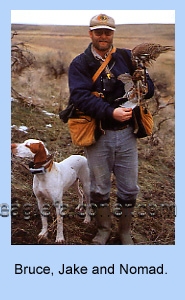
The tiercel fed bareheaded on the fist the next evening, jumped to the fist in a few days, hooded easily, and willingly took tidbits when offered. The fastest way I know for working people to man wild falcons is with a round perch placed in the midst of human traffic. Wild prairie falcons are nervous and their weights must be cut to get their attention. Once they are coming to the fist for food, training proceeds to the next level inside the house via a round perch and outside on the block. With a round perch, the falcon sits high and people do not loom menacingly above it. From this position, it is easy to reach out a small morsel of food on a fingertip and feed the bird as you walk by. Before long, the falcon is anxiously awaiting your entry into the room. Soon after acquiring Nomad, I was scheduled to attend a conference near Seattle. Fortunately, Darryl volunteered to look after the tiercel while I was gone. His strategy for manning the falcon was simple: he put the round perch in his kitchen. The Barnes' girls, the same as children everywhere, delight in scurrying under foot like perpetual motion machines. In the midst of all this commotion, a falcon either dies of fright or learns to ignore it. In daylight hours the action is relentless and, sooner or later, the falcon gives in. After a few days of continuous dawn to dusk stimulus, Nomad found a calmer plane. When I collected him, he was fatter and more relaxed than when I had left. Continuing the manning process at home each evening, I set the round perch in the living room with scattered newspapers and a plastic picnic tablecloth to protect the carpet. Perched on one foot, Nomad casually took in our movements and the workings of the television. After the first few weeks of captivity, Nomad was seldom upset by our activities and relished the tidbits he received sporadically. Maybe he appreciated being warm too. At bedtime, Iput him into the mews. The nighttime temperatures, well below freezing, aided the management of his weight. By the time I was able to fly Nomad free, it was November.
The comfortable fall temperatures were gone, replaced by wind and snow. As anticipated, however, the tiercel was a quick study and took promptly to waiting on. During one training session, it became clear how he had made a living in his former life: he shot off the fist and tried to sneak attack a flock of horned larks. But he soon realized that I was providing him better hunting opportunities, with meals more reliable and substantial than larks.
Always in the back of my mind was the concern that this tiercel would become a "carrier." Both of the passage tiercels I had flown before had been lost because they had carried off small birds. One tiercel seemed inclined this way from the start, and the other I taught to carry in my ignorance. The footing of these passage hawks is deadly and, sooner or later, they catch something small. While telemetry would allow me to recover a skittish tiercel determined to dine "take away," I did not want the frustration and inconvenience of such a vice. I'd had a long conversation about the problem with Tom Smylie at the NAFA field meet in Dodge City, Kansas. In the "old days," Tom had flown passage tundra peregrine tiercels at quail, an easily packed meal should the tiercel be inclined to carry. Tom related a conversation with Jack Mavrogordato on this subject. He said that when Mavrogordato flew Barbary tiercels in North Africa, he learned that larger raptors often pirated their kills. The end result was a "dine and dash" mentality that prompted these pint sized tiercels to carry their quarry to some out of the way place to eat.
Mavrogordato's solution to this problem was to teach the tiercel to leave its kill for food on the lure. To teach the lesson, he garnished the lure with an attractive, pre skinned food item and fed the tiercel generously from it. With this system, the tiercel is fed up when the lure is shown; it is also tid-bitted carefully while it is feeding from the lure on the ground. Tom claimed that the technique had worked well for him for many years. After my previous failures, I was willing to test the technique for myself. I began by attaching a skinned quail breast or half pigeon breast to the lure. Nomad would get a fair meal from this garnish but still fly to the glove to finish his meal for the day. Eventually, the routine became habit and Nomad, too, would leave a fresh kill to eat from the lure. Over the course of the season, Nomad learned to go higher and wait longer to be served. There were no thermals or atmospheric lifts to help him, so he merely powered up into the sky. Small but strong, he left the fist and flew away like he was leaving the country. Out in the distance, he would turn and then mount on his way back above me. Many prairie falcons take a pitch in this manner, a characteristic disconcerting to falconers in the habit of seeing longwings gain height in close, tight circles above them.
But up is up, no matter how a falcon gets there. What matters is the pitch, stoop, and footing. Small tiercels are very flashy in the stoop and their lack of size gives one the impression they are going at great speed. Even at 500 ft, a tiercel prairie looks quite high. With his white belly, Nomad was sometimes difficult to spot in a pale blue sky with a snowy backdrop of rolling hills and mountain peaks. His footing, as I expected, was dead on. Because a tiercel prairie weighs a mere 16 oz, one does not expect it to generate a heavy-weight impact. But its striking power is nothing short of remarkable. It does not have exceptionally large toes for binding to quarry, so it compensates with a serious knock-out punch. As the training progressed, I monitored my goals for the season. The tiercel was now well mannered, took a respectable pitch, and did not seem inclined to carry. Plus, he was a joy to have around the house, an "easy keeper." The endearing nature of tiercel prairies, eyas or passage, has not been fully appreciated, in my opinion. One simply needs to experience the development of a close relationship with a wild falcon, less than three months removed from the trap, to value this characteristic. However, behavior among prairie falcons is highly variable and each one must be treated as an individual. It was at this stage, in the grips of winter, that we found ourselves ready to begin the search for game. Not far from my home are rolling hills frequented by gray partridge and the occasional pheasant. Back in the late 1980s, before years of drought, there were good numbers of partridge. This is where I took my puppy, Jake, to run on wild birds. These days, the ground holds precious few coveys and the cover is thick enough to cause problems. None of this mattered when I had my old hawking team geared up. My intermewed passage red-naped shaheen, Jasmine, took a truly spectacular pitch on a daily basis. She regularly waited-on for an hour or more while I ran the dogs. And, if the partridge ditched themselves in some island of thick cover far away, I simply waiteduntil the falcon had regained her pitch, worked the dogs into the birds, and put them out again. Without a doubt, Jasmines's greatest attribute in this situation was her propensity for binding to partridge. An outstanding duck hawk, she routinely struck waterfowl to the ground. Somehow, she knew that knocking partridge into dense sagebrush was a losing proposition, one that would significantly delay her feeding. Shaheens have huge feet for their size and Jasmine's binds on partridge were permanent. Getting Nomad entered was more difficult than I expected. He was game enough to chase partridge, but they just kept disappearing into cover after being struck. Oddly, Nomad would not readily go back up for a reflush. In fact, he kept flying back toward me to land on a nearby bush or my glove. I soon learned to hood him, wait 15 minutes, and send him up again. After a break, he went right back up. Curiously, he would stoop repeatedly at other birds.
Perhaps his ability to connect with partridge, then have them escape, dampened his spirits to some degree. Some game hawks do have fragile psyches and Nomad was more sensitive than most. In hindsight, I should have abandoned the nearby hills and looked for partridge in lighter cover, a situation that would have resulted in cleaner kills and reinforced his pitch. I don't think I ever flew a falcon more stubborn about not going back up after knocking quarry down. I'm sure this was frustration on his part, coupled with his determination to catch game he had hit, even if it had become buried in cover. But the team persisted and we eventually got Nomad entered to partridge. With exposure to game, his pitch got better, the dog work improved, and I was satisfied that my assumptions about this sporting match of falcon and quarry were justified. I was not breaking new ground with this form of falconry.
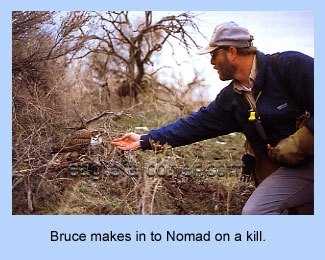
Plenty of falconers have pursued gray partridge with eyas tiercel prairies, with Les Boyd among the notables. Falconer, Bruce Haak and Prairie FalconUnder ideal conditions, in the highly productive wheat-growing region of eastern Washington known as the Palouse Hills, Les has been highly successful hawking this quarry for many years. But it was something different for me to try, and reaffirmed my belief that this versatile raptor is well suited to classic quarry. I delighted in knowing that any bird between the sizes of sparrow and pheasant was fair game for this particular longwing. I could envision tiercel prairies being flown successfully at red-legged partridge as well. We don't have them in Idaho, but I saw red-legged partridge in Suffolk and in Spain, inhabiting open country of primarily plowed dirt. Any partridge there that chose to run in the open, instead of flying, would be safer with a goshawk than a waiting-on prairie falcon. Toward the end of the season, I managed to lose Nomad several times. It took me far too long to deduce that the coaxial cable from my telemetry receiver to the yagi antenna was broken, which explained why I got no transmitter signal and, consequently, couldn't recover him before dark. Occasionally, he would go off self hunting, although usually these excursions were unsuccessful and short-lived. It was during this period, when I could not locate him electronically, that he started coming back to the lure with a full crop. At first I thought it just a fluke, some odd bit of ingrained conditioning that caused him to respond to the lure despite having eaten his fill. But he did this several times, leading me to conclude that he liked me. The feeling was mutual.
I never knew if he would return in an hour or be gone overnight. Any falconer who has spent a sleepless night, worrying about an errant game hawk, can relate to my mental anguish. Arranging time off work to stumble mile after mile over rolling hills in the freezing cold is not my idea of recreation. But my reward was seeing a little brown blur materialize from nowhere, and pop briskly from lure to fist to be hooded. Finally, I figured out the telemetry problem and we got back on track. Near the end of February, Nomad was flying great. Over a weekend, I took him to the Nevada border so my wife could indulge her fondness for nickel slot machines. Gambling is not legal in Idaho. At Jackpot, several casinos have been built within walking distance of the Nevada/Idaho state line. We reserved a motel room next to a patch of lawn so I could take Nomad and Jake along. I hadn't hawked in this part of Idaho in years, so I phoned Charles Browning, a local falconer, for some leads. Coveys of gray partridge spend most of the year within a home range with a radius of about three quarters of a mile. In that regard, they are dependable quarry. I generally begin my search for a covey in the last place I saw then. Charles flies big falcons and a golden eagle, so he pays little attention to partridge. As we talked on the phone, Charles wracked his brain for a covey that might suffice. Eventually, he recalled running into partridge just north of the border. His directions read like a map to buried treasure, complete with an "X" to mark the spot. The next afternoon, I met up with Steve Van Zandt, who drove down from Twin Falls to see the prairie in action. It was a beautiful day, clear and cold with a cloudless sky the color of my blue '67 Volkswagen "Bug." Charles' directions led us to a field that looked like every other field for miles around. I was skeptical. All of the sagebrush to the east had been removed, replaced by an expansive plowed pasture awaiting spring planting.
We rigged up the tiercel, grabbed assorted hawking paraphernalia, and turned Jake loose. A fence line ran north to south. Starting to the west, we tramped a stand of low sage that bordered on an adjacent farm. Jake quartered the ground at quick time, swerving back to meet us before racing off to search in the direction we were now facing. So far, no good. The other side of the fence seemed a long shot. The ground had been plowed in the fall and the furrows were little more than traps for wind-driven tumble weeds. Up to that point, the outing was a pleasant stroll on a lovely late-winter afternoon, nothing more. Steve's stories were amusing and Jake was thoroughly engrossed in exploring new terrain. Suddenly, the tone changed. Out in the distance, Jake was on point.
Nomad was more than ready to fly, even though it was rather early in the day. He sat sedately as I slipped the hood, and then left the fist on a low outrun for a quarter of a mile before he turned and started to mount. The country was relatively flat and open--one could see for miles in any direction and Nomad had no problem keeping us in sight. He was climbing to his pitch at a distance. It was then I realized we should savor the scene. The hawk was within sight and climbing, Jake was locked on point, and the season was drawing to a close. Standing 100 yards from the dog, the falcon circling in and out of the sun, I knew this was the most glorious day for hawking all year. Nomad must have agreed because he kept going higher, even though there was no wind, which is unusual here. Eventually, the tiercel's orbit brought him overhead.
Before we moved in for the flush, I reminded Steve to fix his eyes on Nomad. It was getting difficult to observe the tiercel and at least one of us should see the stoop from start to finish. We marched in front of the dog and up popped a pair of partridge. As soon as the partridge sprang into the air, the tiercel began his stoop. The quarry were far out into the open plow, at least two hundred yards from any kind of cover. I had walked in to the dog from the nearest cover and both partridge flew around me in an arc, headed in that direction. Instinctively I yelled, but Nomad was already on the way down. A few seconds later, I spotted him at about the 600 ft mark, tucked into a tight teardrop. He was closing the gap from a spectacular pitch and coming nearly straight down over our heads. By this time, the partridge were at full speed. But there was no help for them. With surgical precision, Nomad simply sliced one out of the air, hitting it hard enough that the partridge didn't even twitch. We gathered around to honor the kill and pay our respects to the dearly departed. Down in a deep furrow, Nomad nonchalantly plumed his quarry. The sun radiated on the horizon as we took in the sudden silence of the scene. This was to be the final flight before the molt, and I couldn't imagine a finer ending to the season. Yet I knew there was more to learn about the passage tiercel prairie falcon and I resolved to explore further itsexciting potential as a game hawk.
